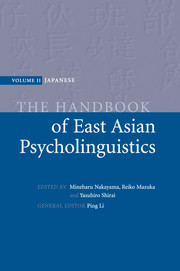Book contents
- Frontmatter
- Contents
- List of figures
- List of contributors
- In memory of Miwa Nishimura
- Preface
- Introduction
- Language acquisition
- 1 Ontogeny of language
- 2 Caregivers' speech
- 3 The intrinsic link between gesture and speech at the prelinguistic stage
- 4 Infant speech perception
- 5 Phonological acquisition
- 6 The mechanism of lexical development: implications from Japanese children's word learning
- 7 The acquisition of nouns and verbs in Japanese
- 8 The acquisition of verbal nouns
- 9 The acquisition of Japanese numeral classifiers
- 10 The acquisition of case markers
- 11 The acquisition of tense and aspect
- 12 On the origin of children's errors: the case of Japanese negation and direct passive
- 13 Binding Theory in UG and first-language acquisition of Japanese
- 14 The acquisition of the particles ne, yo, and no
- 15 The acquisition of linguistic politeness in Japanese
- 16 Children's narrative structures
- 17 Memory talk and testimony in children
- 18 Developmental dyslexia
- 19 Japanese Sign Language
- 20 The role of an innate acquisition device in second-language acquisition
- 21 Japanese, the grammar of reflexives, and second-language acquisition
- 22 Processes in L2 Japanese sentence production
- 23 The development of lexical competence among second-language readers
- 24 Reading in Japanese as a second language
- 25 Intrasentential code-switching in Japanese and English
- Part II Language processing
- References
- Name index
- Subject index
5 - Phonological acquisition
from Language acquisition
Published online by Cambridge University Press: 05 June 2012
- Frontmatter
- Contents
- List of figures
- List of contributors
- In memory of Miwa Nishimura
- Preface
- Introduction
- Language acquisition
- 1 Ontogeny of language
- 2 Caregivers' speech
- 3 The intrinsic link between gesture and speech at the prelinguistic stage
- 4 Infant speech perception
- 5 Phonological acquisition
- 6 The mechanism of lexical development: implications from Japanese children's word learning
- 7 The acquisition of nouns and verbs in Japanese
- 8 The acquisition of verbal nouns
- 9 The acquisition of Japanese numeral classifiers
- 10 The acquisition of case markers
- 11 The acquisition of tense and aspect
- 12 On the origin of children's errors: the case of Japanese negation and direct passive
- 13 Binding Theory in UG and first-language acquisition of Japanese
- 14 The acquisition of the particles ne, yo, and no
- 15 The acquisition of linguistic politeness in Japanese
- 16 Children's narrative structures
- 17 Memory talk and testimony in children
- 18 Developmental dyslexia
- 19 Japanese Sign Language
- 20 The role of an innate acquisition device in second-language acquisition
- 21 Japanese, the grammar of reflexives, and second-language acquisition
- 22 Processes in L2 Japanese sentence production
- 23 The development of lexical competence among second-language readers
- 24 Reading in Japanese as a second language
- 25 Intrasentential code-switching in Japanese and English
- Part II Language processing
- References
- Name index
- Subject index
Summary
Introduction
This chapter reviews some important outcomes of developmental research on Japanese phonology, particularly in the area of early production. The review highlights the acquisition of several phonological phenomena in Japanese that are of particular interest from a crosslinguistic perspective, such as durational contrasts, mora-timing, and pitch accent. These are aspects in which Japanese differs typologically from English and several other European languages whose developmental data have been the empirical foundation of much theorizing in language acquisition. As such, the acquisition of these properties provides complementary evidence and insights that can further our general understanding of phonological development.
Segmental development
Development of the segmental inventory
Recent research on early speech production shows that language-specific segmental inventories begin to take shape during the babbling stage. Japanese is no exception. Babbling vocalizations in Japanese contain more nasals in comparison to those in English or Swedish, and fewer labials in comparison to those in French or English (Boysson-Bardies & Vihman, 1991). These findings indicate that children exposed to Japanese are tuning into the frequency distribution of the target segments even before they produce their first words.
Despite this precocious sensitivity to the language-specific phonemic inventory, children do not produce all segments or contrasts from the initial stages of word production. The order in which targetlike production of Japanese segments is achieved has been investigated in a number of cross-sectional studies, typically by means of a word elicitation task and accuracy measurement based on phonetic transcription (e.g. Murata, 1970; Nakajima et al., 1962; Owada, Nakanishi & Oshige, 1969; Sakauchi, 1967; Umebayashi & Takagi, 1965).
- Type
- Chapter
- Information
- The Handbook of East Asian Psycholinguistics , pp. 41 - 47Publisher: Cambridge University PressPrint publication year: 2006
- 4
- Cited by



